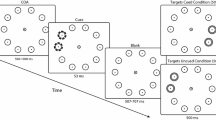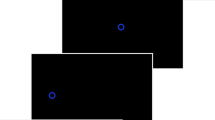Abstract
The inhibition of return (IOR) refers the observer’s slower response time when the target stimulus appears on the previously attended location. In the present study, we examined the time course of saccadic IOR by using five stimuli onset asynchronies (SOAs) in a group of adults with autism spectrum disorders (ASDs) and a comparison group. The results showed that the IOR effect occurred earlier (300 ms SOA) in participants with ASDs, relative to the comparison participants (500 and 700 ms SOAs). The ASD group also committed a greater number of anticipatory saccades, which positively correlated with scores on restricted and repetitive behaviors, as assessed by the Autism Diagnostic Interview-Revised (ADI-R; Lord et al. in J Autism Dev Disord 24:659–685, 1994). These findings reveal an accelerated time course for saccadic IOR along with diminished volitional oculomotor control in participants with ASDs. We discussed these results with reference to the atypical and the superior visual search abilities often reported in this population.



Similar content being viewed by others
References
American Psychiatric Association (2000) Diagnostic and statistical manual of mental disorders: DSM-IV-TR. American Psychiatric Association, Washington, DC
American Psychiatric Association (2013) Diagnostic and statistical manual of mental disorders, 5th edn. American Psychiatric Association, Washington, DC
Baron-Cohen S, Wheelwright S, Skinner R, Martin J, Clubley E (2001) The autism-spectrum quotient (AQ): evidence from Asperger syndrome/high-functioning autism, males and females, scientists and mathematicians. J Autism Dev Disord 31:5–17
Briand KA, Larrison AL, Sereno AB (2000) Inhibition of return in manual and saccadic response systems. Percept Psychophys 62(8):1512–1524
Caron M-J, Mottron L, Berthiaume C, Dawson M (2006) Cognitive mechanisms, specificity and neural underpinnings of visuospatial peaks in autism. Brain 129:1789–1802
Casey BJ, Gordon CT, Mannheim GB, Rumsey JM (1993) Dysfunctional attention in autistic savants. J Clin Exp Neuropsychol 15(6):933–946
Dakin S, Frith U (2005) Vagaries of visual perception in autism. Neuron 48:497–507
Dorris MC, Klein RM, Everling S, Munoz DP (2002) Contribution of the primate superior colliculus to inhibition of return. J Cogn Neurosci 14(8):1256–1263
Elsabbagh M, Fernandes J, Jane Webb S, Dawson G, Charman T, Johnson MH, The British Autism Study of Infant Siblings Team (2013) Disengagement of visual attention in infancy is associated with emerging autism in toddlerhood. Biol Psychiatry 74(3):189–194
Everling S, Johnston K (2013) Control of the superior colliculus by the lateral prefrontal cortex. Philos Trans R Soc Lond B Biol Sci 368(1628):20130068
Gillberg C, Gillberg C, Råstam M, Wentz E (2001) The Asperger Syndrome (and high-functioning autism) Diagnostic Interview (ASDI): a preliminary study of a new structured clinical interview. Autism 5:57–66
Goldberg MC, Lasker AG, Zee DS, Garth E, Tien A, Landa RJ (2002) Deficits in the initiation of eye movements in the absence of a visual target in adolescents with high functioning autism. Neuropsychologia 40:2039–2049
Guitton D, Buchtel HA, Douglas RM (1985) Frontal lobe lesions in man cause difficulties in suppressing reflexive glances and in generating goal-directed saccades. Exp Brain Res 58:455–472
Harris NS, Courchesne E, Townsend J, Carper RA, Lord C (1999) Neuroanatomic contributions to slowed orienting of attention in children with autism. Cogn Brain Res 8:61–71
Iarocci G, Burack JA (2004) Intact covert orienting to peripheral cues among children with autism. J Autism Dev Disord 34:257–264
Johnson BP, Rinehart NJ, Papadopoulos N, Tonge B, Millist L, White O, Fielding J (2012) A closer look at visually guided saccades in autism and Asperger’s disorder. Front Integr Neurosci 6:99
Jolliffe T, Baron-Cohen S (1997) Are people with autism and Asperger syndrome faster than normal on the Embedded Figures Test? J Child Psychol Psychiatry 38:527–534
Joseph RM, Keehn B, Connolly C et al (2009) Why is visual search superior in autism spectrum disorder? Dev Sci 12:1083–1096
Keehn B, Müller RA, Townsend J (2013) Atypical attentional networks and the emergence of autism. Neurosci Biobehav Rev 37(2):164–183
Kemner C, van Ewijk L, van Engeland H, Hooge I (2008) Brief report: eye movements during visual search tasks indicate enhanced stimulus discriminability in subjects with PDD. J Autism Dev Disord 38:553–557
Klein RM (2000) Inhibition of return. Trends Cogn Sci 4(4):138–147
Klein RM, MacInnes WJ (1999) Inhibition of return is a foraging facilitator in visual search. Psychol Sci 10:346–352
Klin A, Jones W, Schultz R, Volkmar F, Cohen D (2002) Visual fixation patterns during viewing of naturalistic social situations as predictors of social competence in individuals with autism. Arch Gen Psychiatry 59:809–816
Landry O, Parker A (2013) A meta-analysis of visual orienting in autism. Front Hum Neurosci 9(7):833
Langen M, Durston S, Kas MJ, van Engeland H, Staal WG (2011) The neurobiology of repetitive behavior. Neurosci Biobehav Rev 35(3):356–365
Lopez BR, Lincoln AJ, Ozonoff S, Lai Z (2005) Examining the relationship between executive functions and restricted, repetitive symptoms of autistic disorder. J Autism Dev Disord 35(4):445–460
Lord C, Rutter M, Le Couteur A (1994) Autism diagnostic interview-revised: a revised version of a diagnostic interview for caregivers of individuals with possible pervasive developmental disorders. J Autism Dev Disord 24:659–685
Lord C, Risi S, Lambrecht L, Cook EH Jr, Leventhal BL, DiLavore PC, Pickles A, Rutter M (2000) The autism diagnostic observation schedule-generic: a standard measure of social and communication deficits associated with the spectrum of autism. J Autism Dev Disord 30:205–223
Luna B, Doll SK, Hegedus SJ, Minshew NJ, Sweeney JA (2007) Maturation of executive function in autism. Biol Psychiatry 61:474–481
Manoach DS, Lindgren KA, Barton JJS (2004) Deficient saccadic inhibition in Asperger’s disorder and the social-emotional processing disorder. J Neurol Neurosurg Psychiatry 75:1719–1726
Marotta A, Pasini A, Ruggiero S, Maccari L, Rosa C, Lupiáñez J, Casagrande M (2013) Inhibition of return in response to eye gaze and peripheral cues in young people with Asperger’s syndrome. J Autism Dev Disord 43:917–923
McDonald JJ, Ward LM (1999) Spatial relevance determines facilitatory and inhibitory effects of auditory covert spatial orienting. J Exp Psychol Hum Percept Perform 25:1234–1252
Minshew NJ, Luna B, Sweeney JA (1999) Oculomotor evidence for neocortical systems but not cerebellar dysfunction in autism. Neurology 52:917–922
Mosconi MW, Kay M, D’Cruz A-M, Seidenfeld A, Guter S, Stanford LD, Sweeney JA (2009) Impaired inhibitory control is associated with higher-order repetitive behaviors in autism spectrum disorders. Psychol Med 39:1559–1566
Mosconi MW, Kay M, D’Cruz A-M, Guter S, Kapur K, Macmillan C, Sweeney JA (2010) Neurobehavioral abnormalities in first-degree relatives of individuals with autism. Arch Gen Psychiatry 67:830–840
Mottron L, Burack JA (2001) Enhanced perceptual functioning in the development of autism. In: Burack JA, Charman T, Yirmiya N, Zelazo PR (eds) The development of autism: perspectives from theory and research. Lawrence Erlbaum Associates, Mahwah, pp 131–148
Mottron L, Dawson M, Soulières I, Hubert L, Burack JA (2006) Enhanced perceptual functioning in autism: an update, and eight principles of autistic perception. J Autism Dev Disord 36:27–43
Munoz DP, Dorris MC, Pare M, Everling S (2000) On your mark, get set: brainstem circuitry underlying saccadic initiation. Can J Physiol Pharmacol 78:934–944
Nowinski CV, Minshew NJ, Luna B, Takarae Y, Sweeney JA (2005) Oculomotor studies of cerebellar function in autism. Psychiatry Res 137:11–19
O’Riordan M, Plaisted K (2001) Enhanced discrimination in autism. Q J Exp Psychol A 54:961–979
O’Riordan MA, Plaisted KC, Driver J, Baron-Cohen S (2001) Superior visual search in autism. J Exp Psychol Hum Percept Perform 27:719–730
Pennington BF, Ozonoff S (1996) Executive functions and developmental psychopathology. J Child Psychol Psychiatry 37:51–87
Plaisted K, O’Riordan M, Baron-Cohen S (1998) Enhanced visual search for a conjunctive target in autism: a research note. J Child Psychol Psychiatry 39:777–783
Posner M, Cohen Y (1984) Components of visual orienting. In: Bouma H, Bouwhuis DG (eds) Attention and performance. Lawrence Erlbaum Associates, London, pp 531–556
Posner MI, Petersen SE (2012) The attention system of the human brain: 20 years after. Annu Rev Neurosci 35:73–89
Posner MI, Cohen Y, Rafal RD (1982) Neural systems control of spatial orienting. Philos Trans R Soc Lond B Biol Sci 298:187–198
Pruett JR Jr, LaMacchia A, Hoertel S, Squire E, McVey K, Todd RD, Constantino JN, Petersen SE (2011) Social and non-social cueing of visuospatial attention in autism and typical development. J Autism Dev Disord 41(6):715–731
Rinehart NJ, Bradshaw JL, Moss SA, Brereton AV, Tonge BJ (2008) Brief report: inhibition of return in young people with autism and Asperger’s disorder. Autism 12:249–260
Samuel AG, Kat D (2003) Inhibition of return: a graphical meta-analysis of its time course and an empirical test of its temporal and spatial properties. Psychon Bull Rev 10:897–906
Shah A, Frith U (1983) An islet of ability in autistic children: a research note. J Child Psychol Psychiatry 24:613–620
Shah A, Frith U (1993) Why do autistic individuals show superior performance on the block design task? J Child Psychol Psychiatry 34:1351–1364
Stanley-Cary C, Rinehart N, Tonge B, White O, Fielding J (2011) Greater disruption to control of voluntary saccades in autistic disorder than Asperger’s disorder: evidence for greater cerebellar involvement in autism? Cerebellum 10:70–80
Takarae Y, Minshew NJ, Luna B, Sweeney JA (2004) Oculomotor abnormalities parallel cerebellar histopathology in autism. J Neurol Neurosurg Psychiatry 75:1359–1361
Takarae Y, Minshew NJ, Luna B, Sweeney JA (2007) Atypical involvement of frontostriatal systems during sensorimotor control in autism. Psychiatry Res 156:117–127
Thomas LE, Ambinder MS, Hsieh B, Levinthal B, Crowell JA, Irwin DE, Kramer AF, Lleras A, Simons DJ, Wang RF (2006) Fruitful visual search: inhibition of return in a virtual foraging task. Psychon Bull Rev 13:891–895
Tipper SP, Rafal R, Reuter-Lorenz PA, Starrveldt Y, Ro T, Egly R, Weaver B (1997) Object-based facilitation and inhibition from visual orienting in the human split-brain. J Exp Psychol Hum Percept Perform 23:1522–1532
Wang Z, Satel J, Klein RM (2012) Sensory and motor mechanisms of oculomotor inhibition of return. Exp Brain Res 218(3):441–453
Wing L (1976) Diagnosis, clinical description and prognosis. In: Wing L (ed) Early childhood autism. Pergamon, Oxford, pp 15–48
Zwaigenbaum L, Bryson S, Rogers T, Roberts W, Brian J, Szatmari P (2005) Behavioral manifestations of autism in the first year of life. Int J Dev Neurosci 23:143–152
Zwaigenbaum L, Bryson S, Lord C, Rogers S, Carter A, Carver L, Yirmiya N (2009) Clinical assessment and management of toddlers with suspected autism spectrum disorder: insights from studies of high-risk infants. Pediatrics 123:1383–1391
Acknowledgments
We would like to thank all the participants and their families for generously volunteering their time to participate in this study. The authors wish to thank Doriane Gras and Laura Fernandez for their helpful comments on a previous version of the manuscript. This research was supported by Fondation FondaMental and Fondation Orange.
Conflict of interest
The authors declare that they have no conflict of interest.
Author information
Authors and Affiliations
Corresponding author
Rights and permissions
About this article
Cite this article
Pieron, M., Seassau, M., Leboyer, M. et al. Accelerated time course of saccadic inhibition of return in individuals with autism spectrum disorders. Exp Brain Res 233, 767–775 (2015). https://doi.org/10.1007/s00221-014-4152-1
Received:
Accepted:
Published:
Issue Date:
DOI: https://doi.org/10.1007/s00221-014-4152-1




